Report on Entrepreneurship and Small Business Management-Unit 9
VerifiedAdded on 2023/01/19
|20
|5314
|36
Report
AI Summary
This report provides a comprehensive overview of entrepreneurship and small business management, beginning with a discussion of different types of entrepreneurial ventures, including small to medium-sized ventures, social orientation businesses, start-ups, large-scale businesses, and private/public sector ventures, highlighting their similarities and differences. It further examines the impact of micro and small businesses on the economy, supported by statistics, and emphasizes their importance for social economy growth. The report identifies key characteristics and skills of successful entrepreneurs and assesses entrepreneurial personality traits, motivations, and mindsets. Finally, it explores factors that hinder entrepreneurship, providing relevant examples, and concludes with a summary of key findings, emphasizing the role of innovation, customer orientation, and strategic financial planning in entrepreneurial success. Desklib offers similar study resources for students.

Unit 9 - Entrepreneurship and
Small Business Management
Small Business Management
Paraphrase This Document
Need a fresh take? Get an instant paraphrase of this document with our AI Paraphraser
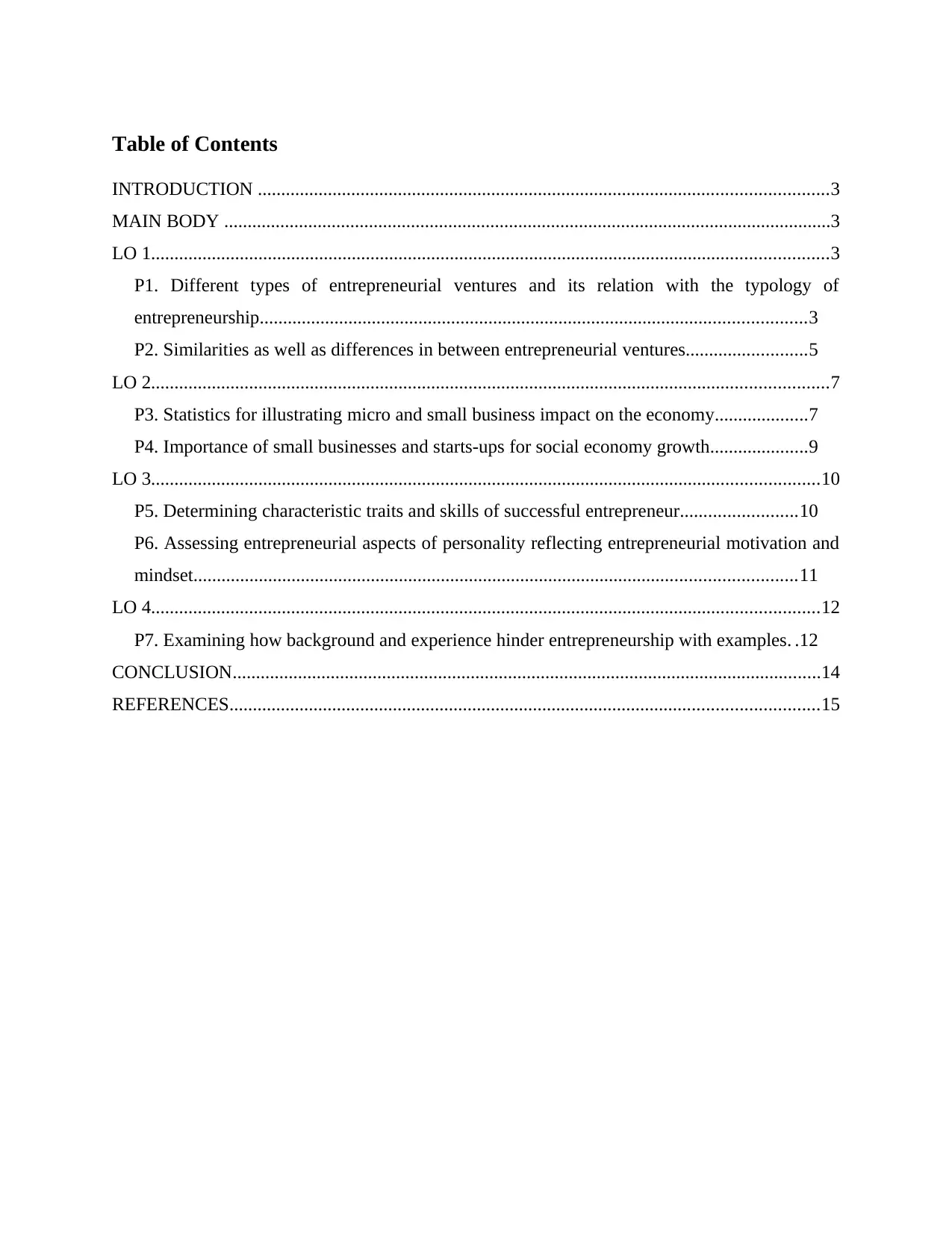
Table of Contents
INTRODUCTION ..........................................................................................................................3
MAIN BODY ..................................................................................................................................3
LO 1.................................................................................................................................................3
P1. Different types of entrepreneurial ventures and its relation with the typology of
entrepreneurship.....................................................................................................................3
P2. Similarities as well as differences in between entrepreneurial ventures..........................5
LO 2.................................................................................................................................................7
P3. Statistics for illustrating micro and small business impact on the economy....................7
P4. Importance of small businesses and starts-ups for social economy growth.....................9
LO 3...............................................................................................................................................10
P5. Determining characteristic traits and skills of successful entrepreneur.........................10
P6. Assessing entrepreneurial aspects of personality reflecting entrepreneurial motivation and
mindset.................................................................................................................................11
LO 4...............................................................................................................................................12
P7. Examining how background and experience hinder entrepreneurship with examples. .12
CONCLUSION..............................................................................................................................14
REFERENCES..............................................................................................................................15
INTRODUCTION ..........................................................................................................................3
MAIN BODY ..................................................................................................................................3
LO 1.................................................................................................................................................3
P1. Different types of entrepreneurial ventures and its relation with the typology of
entrepreneurship.....................................................................................................................3
P2. Similarities as well as differences in between entrepreneurial ventures..........................5
LO 2.................................................................................................................................................7
P3. Statistics for illustrating micro and small business impact on the economy....................7
P4. Importance of small businesses and starts-ups for social economy growth.....................9
LO 3...............................................................................................................................................10
P5. Determining characteristic traits and skills of successful entrepreneur.........................10
P6. Assessing entrepreneurial aspects of personality reflecting entrepreneurial motivation and
mindset.................................................................................................................................11
LO 4...............................................................................................................................................12
P7. Examining how background and experience hinder entrepreneurship with examples. .12
CONCLUSION..............................................................................................................................14
REFERENCES..............................................................................................................................15
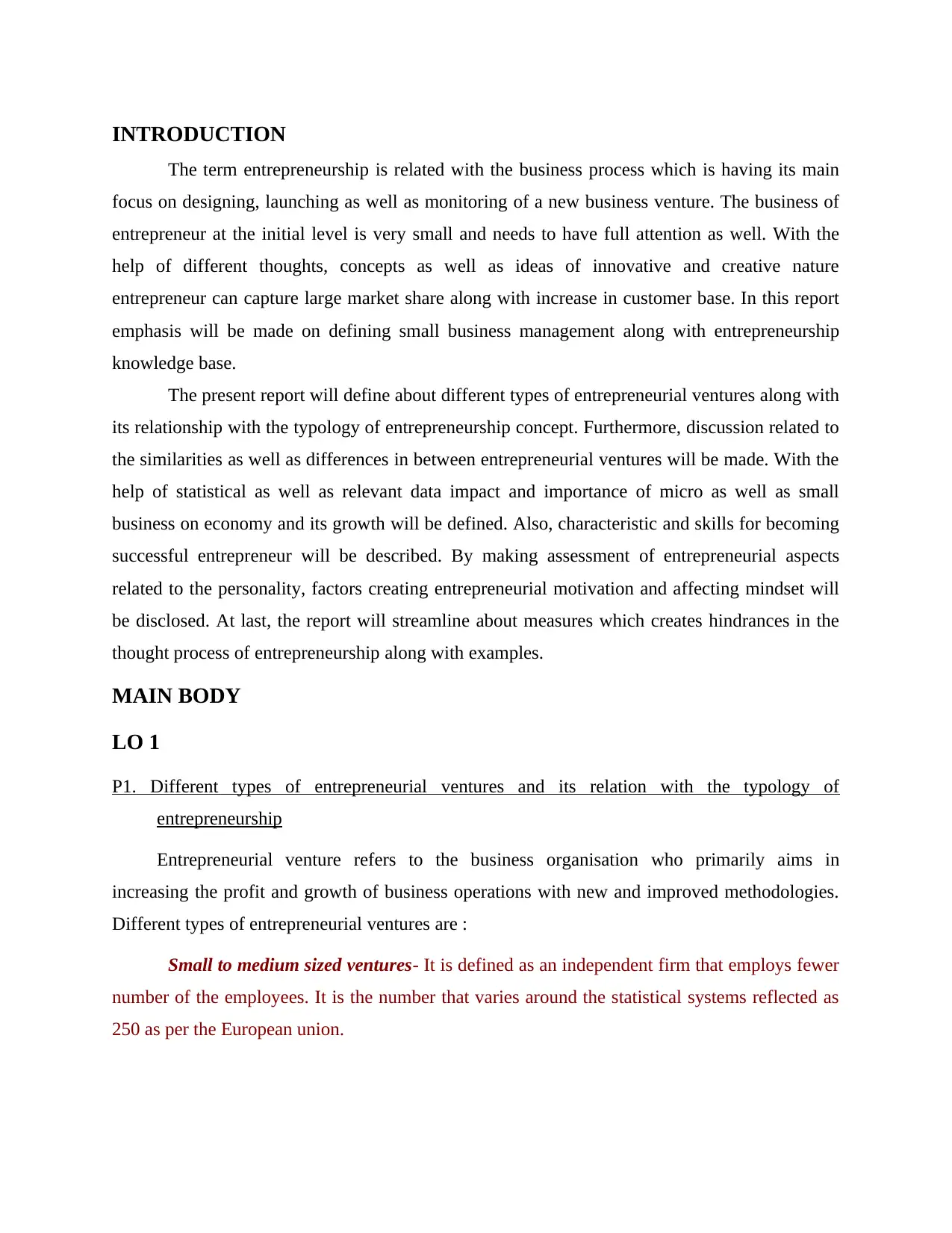
INTRODUCTION
The term entrepreneurship is related with the business process which is having its main
focus on designing, launching as well as monitoring of a new business venture. The business of
entrepreneur at the initial level is very small and needs to have full attention as well. With the
help of different thoughts, concepts as well as ideas of innovative and creative nature
entrepreneur can capture large market share along with increase in customer base. In this report
emphasis will be made on defining small business management along with entrepreneurship
knowledge base.
The present report will define about different types of entrepreneurial ventures along with
its relationship with the typology of entrepreneurship concept. Furthermore, discussion related to
the similarities as well as differences in between entrepreneurial ventures will be made. With the
help of statistical as well as relevant data impact and importance of micro as well as small
business on economy and its growth will be defined. Also, characteristic and skills for becoming
successful entrepreneur will be described. By making assessment of entrepreneurial aspects
related to the personality, factors creating entrepreneurial motivation and affecting mindset will
be disclosed. At last, the report will streamline about measures which creates hindrances in the
thought process of entrepreneurship along with examples.
MAIN BODY
LO 1
P1. Different types of entrepreneurial ventures and its relation with the typology of
entrepreneurship
Entrepreneurial venture refers to the business organisation who primarily aims in
increasing the profit and growth of business operations with new and improved methodologies.
Different types of entrepreneurial ventures are :
Small to medium sized ventures- It is defined as an independent firm that employs fewer
number of the employees. It is the number that varies around the statistical systems reflected as
250 as per the European union.
The term entrepreneurship is related with the business process which is having its main
focus on designing, launching as well as monitoring of a new business venture. The business of
entrepreneur at the initial level is very small and needs to have full attention as well. With the
help of different thoughts, concepts as well as ideas of innovative and creative nature
entrepreneur can capture large market share along with increase in customer base. In this report
emphasis will be made on defining small business management along with entrepreneurship
knowledge base.
The present report will define about different types of entrepreneurial ventures along with
its relationship with the typology of entrepreneurship concept. Furthermore, discussion related to
the similarities as well as differences in between entrepreneurial ventures will be made. With the
help of statistical as well as relevant data impact and importance of micro as well as small
business on economy and its growth will be defined. Also, characteristic and skills for becoming
successful entrepreneur will be described. By making assessment of entrepreneurial aspects
related to the personality, factors creating entrepreneurial motivation and affecting mindset will
be disclosed. At last, the report will streamline about measures which creates hindrances in the
thought process of entrepreneurship along with examples.
MAIN BODY
LO 1
P1. Different types of entrepreneurial ventures and its relation with the typology of
entrepreneurship
Entrepreneurial venture refers to the business organisation who primarily aims in
increasing the profit and growth of business operations with new and improved methodologies.
Different types of entrepreneurial ventures are :
Small to medium sized ventures- It is defined as an independent firm that employs fewer
number of the employees. It is the number that varies around the statistical systems reflected as
250 as per the European union.
⊘ This is a preview!⊘
Do you want full access?
Subscribe today to unlock all pages.

Trusted by 1+ million students worldwide
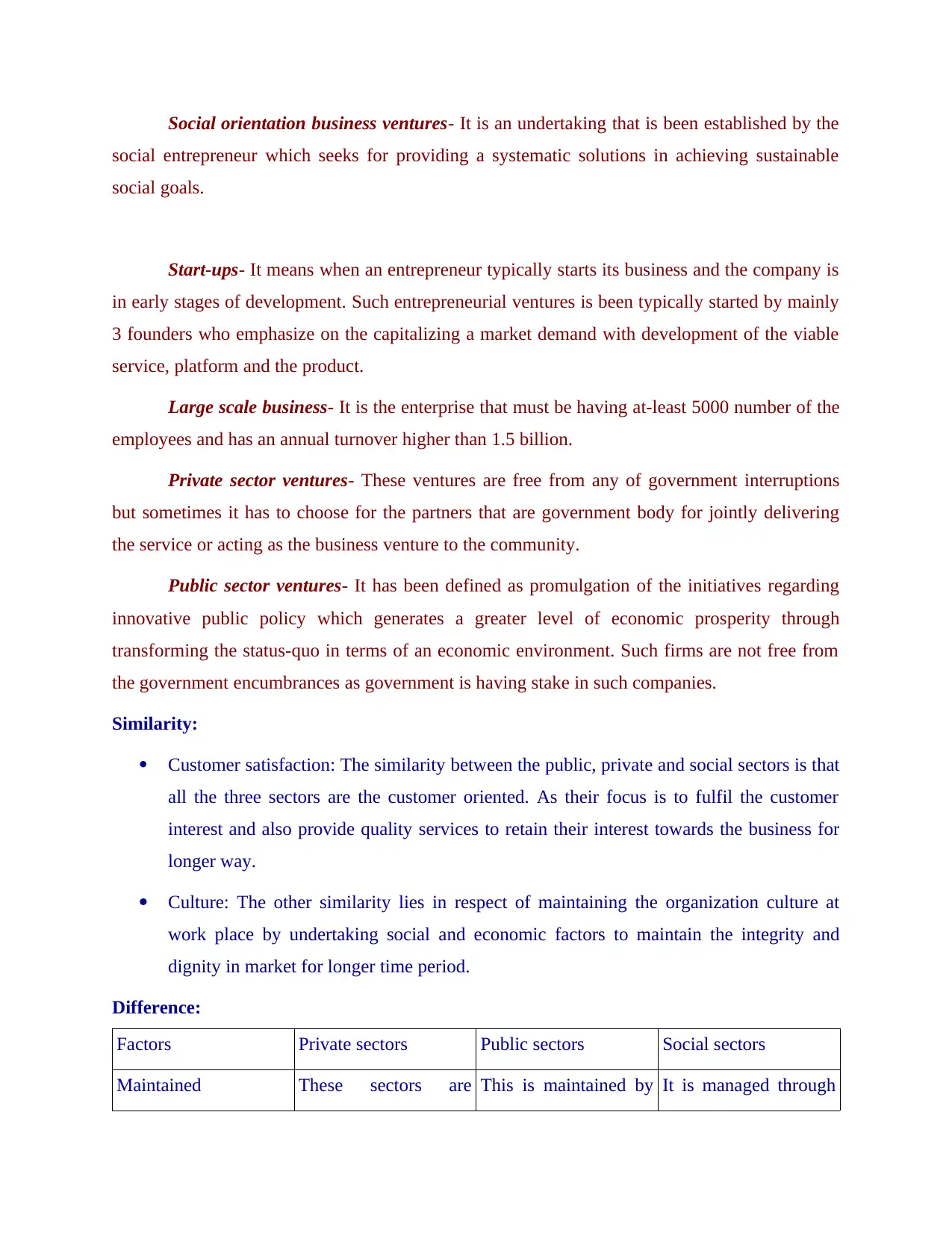
Social orientation business ventures- It is an undertaking that is been established by the
social entrepreneur which seeks for providing a systematic solutions in achieving sustainable
social goals.
Start-ups- It means when an entrepreneur typically starts its business and the company is
in early stages of development. Such entrepreneurial ventures is been typically started by mainly
3 founders who emphasize on the capitalizing a market demand with development of the viable
service, platform and the product.
Large scale business- It is the enterprise that must be having at-least 5000 number of the
employees and has an annual turnover higher than 1.5 billion.
Private sector ventures- These ventures are free from any of government interruptions
but sometimes it has to choose for the partners that are government body for jointly delivering
the service or acting as the business venture to the community.
Public sector ventures- It has been defined as promulgation of the initiatives regarding
innovative public policy which generates a greater level of economic prosperity through
transforming the status-quo in terms of an economic environment. Such firms are not free from
the government encumbrances as government is having stake in such companies.
Similarity:
Customer satisfaction: The similarity between the public, private and social sectors is that
all the three sectors are the customer oriented. As their focus is to fulfil the customer
interest and also provide quality services to retain their interest towards the business for
longer way.
Culture: The other similarity lies in respect of maintaining the organization culture at
work place by undertaking social and economic factors to maintain the integrity and
dignity in market for longer time period.
Difference:
Factors Private sectors Public sectors Social sectors
Maintained These sectors are This is maintained by It is managed through
social entrepreneur which seeks for providing a systematic solutions in achieving sustainable
social goals.
Start-ups- It means when an entrepreneur typically starts its business and the company is
in early stages of development. Such entrepreneurial ventures is been typically started by mainly
3 founders who emphasize on the capitalizing a market demand with development of the viable
service, platform and the product.
Large scale business- It is the enterprise that must be having at-least 5000 number of the
employees and has an annual turnover higher than 1.5 billion.
Private sector ventures- These ventures are free from any of government interruptions
but sometimes it has to choose for the partners that are government body for jointly delivering
the service or acting as the business venture to the community.
Public sector ventures- It has been defined as promulgation of the initiatives regarding
innovative public policy which generates a greater level of economic prosperity through
transforming the status-quo in terms of an economic environment. Such firms are not free from
the government encumbrances as government is having stake in such companies.
Similarity:
Customer satisfaction: The similarity between the public, private and social sectors is that
all the three sectors are the customer oriented. As their focus is to fulfil the customer
interest and also provide quality services to retain their interest towards the business for
longer way.
Culture: The other similarity lies in respect of maintaining the organization culture at
work place by undertaking social and economic factors to maintain the integrity and
dignity in market for longer time period.
Difference:
Factors Private sectors Public sectors Social sectors
Maintained These sectors are This is maintained by It is managed through
Paraphrase This Document
Need a fresh take? Get an instant paraphrase of this document with our AI Paraphraser

owned and managed
by the individuals
itself.
the government. charity function or any
type of events related
to donation activity.
Aim Main aim is to earn
profits.
Is to serve the public
through fulfilling their
needs and wants.
Aims is to be helps the
needy people to
manage the life in
better way.
Job security and
benefits
No such security is
given to employees
but if the employees
are employed in
private sectors, they
enjoy the benefit such
as getting safety
policies or also getting
chances of high post
recruitment.
The security is higher
in public sectors jobs
and also the benefits
such as gratuity,
pension and
superannuation fund is
to be given to
employees for better
work.
As such no job
security, every person
are free to work in that
place. The benefits
which they enjoy is
relating to carrying
wider range of
knowledges, as social
sectors is one of the
fastest growing sectors
in country.
1. Small Business – This type of ventures are generally owned and operated by self.
Main aim is to grow, make profit significantly and convert into large business with
time (Alvarez, Audretsch and Link, 2016). Funds in these cases are raised through
bank loans, or personal funds. Some of the common small businesses are of hair
salons, retail shops, cafes and restaurants. This kind of business are sometime capable
of generating a few jobs.
2. Large Business – Large business are the organisations which grow more and more by
adopting market needs and releasing new product variants as per the market changes.
They operate at big level, having many employees working for the organisation’s
by the individuals
itself.
the government. charity function or any
type of events related
to donation activity.
Aim Main aim is to earn
profits.
Is to serve the public
through fulfilling their
needs and wants.
Aims is to be helps the
needy people to
manage the life in
better way.
Job security and
benefits
No such security is
given to employees
but if the employees
are employed in
private sectors, they
enjoy the benefit such
as getting safety
policies or also getting
chances of high post
recruitment.
The security is higher
in public sectors jobs
and also the benefits
such as gratuity,
pension and
superannuation fund is
to be given to
employees for better
work.
As such no job
security, every person
are free to work in that
place. The benefits
which they enjoy is
relating to carrying
wider range of
knowledges, as social
sectors is one of the
fastest growing sectors
in country.
1. Small Business – This type of ventures are generally owned and operated by self.
Main aim is to grow, make profit significantly and convert into large business with
time (Alvarez, Audretsch and Link, 2016). Funds in these cases are raised through
bank loans, or personal funds. Some of the common small businesses are of hair
salons, retail shops, cafes and restaurants. This kind of business are sometime capable
of generating a few jobs.
2. Large Business – Large business are the organisations which grow more and more by
adopting market needs and releasing new product variants as per the market changes.
They operate at big level, having many employees working for the organisation’s

profit and growth. They aim towards the profit of the company itself and its
stakeholders. Examples of this large business are Google, Microsoft, Apple.
3. Lifestyle Business – Lifestyle business are generally set by Freelancers. They use
their skills, innovative ideas, expertise for making the profit. This type of business are
set with a particular level of income and to enjoy a set lifestyle. They are operated by
individuals and doesn’t provide any employment. This kind of business are mainly
depended on the founder’s skill and capability. Some examples of such firms are
Personal bloggers, photographers, writers, novelist.
4. Social Business – Social business foundation is led on the innovative ideas and
improved ways of dealing with day to day problems. The aim is to solve the health
related issues, other public issues in world, majorly in developing and under
developed countries (Bruton, Ahlstrom and Si, 2015). They raise funds based on their
contacts. Such business are focused on improving living standards and could be both
profit and non-profit making organisations. Some ideas of social business are used
textbooks for social change, small water stations in developing countries, social
crowdfunding.
Relation of entrepreneurial ventures with the typology of entrepreneurship are as follows:
An entrepreneur is a single person who has a proper idea and a well planned strategy of starting a
business operation. At the initial stage, the amount of resources would be very less as compared
to work. Risk planning and mitigation are always considered at the initial phase. All the loss and
profit are beared by the entrepreneur itself. The idea of starting a business always resolves
around launching a new useful product in the market, instead of modifying an already existing
product. Typology here would be used to understand the connection and similarity between the
enterprises. It helps in understanding all the research done by entrepreneur before starting a
business.
Similarity:
The similarity between the small, medium and micro business is that:
Innovative: They all carry the equal motive to bring innovation at work place so that they
can attract the customer towards the business for longer way.
stakeholders. Examples of this large business are Google, Microsoft, Apple.
3. Lifestyle Business – Lifestyle business are generally set by Freelancers. They use
their skills, innovative ideas, expertise for making the profit. This type of business are
set with a particular level of income and to enjoy a set lifestyle. They are operated by
individuals and doesn’t provide any employment. This kind of business are mainly
depended on the founder’s skill and capability. Some examples of such firms are
Personal bloggers, photographers, writers, novelist.
4. Social Business – Social business foundation is led on the innovative ideas and
improved ways of dealing with day to day problems. The aim is to solve the health
related issues, other public issues in world, majorly in developing and under
developed countries (Bruton, Ahlstrom and Si, 2015). They raise funds based on their
contacts. Such business are focused on improving living standards and could be both
profit and non-profit making organisations. Some ideas of social business are used
textbooks for social change, small water stations in developing countries, social
crowdfunding.
Relation of entrepreneurial ventures with the typology of entrepreneurship are as follows:
An entrepreneur is a single person who has a proper idea and a well planned strategy of starting a
business operation. At the initial stage, the amount of resources would be very less as compared
to work. Risk planning and mitigation are always considered at the initial phase. All the loss and
profit are beared by the entrepreneur itself. The idea of starting a business always resolves
around launching a new useful product in the market, instead of modifying an already existing
product. Typology here would be used to understand the connection and similarity between the
enterprises. It helps in understanding all the research done by entrepreneur before starting a
business.
Similarity:
The similarity between the small, medium and micro business is that:
Innovative: They all carry the equal motive to bring innovation at work place so that they
can attract the customer towards the business for longer way.
⊘ This is a preview!⊘
Do you want full access?
Subscribe today to unlock all pages.

Trusted by 1+ million students worldwide
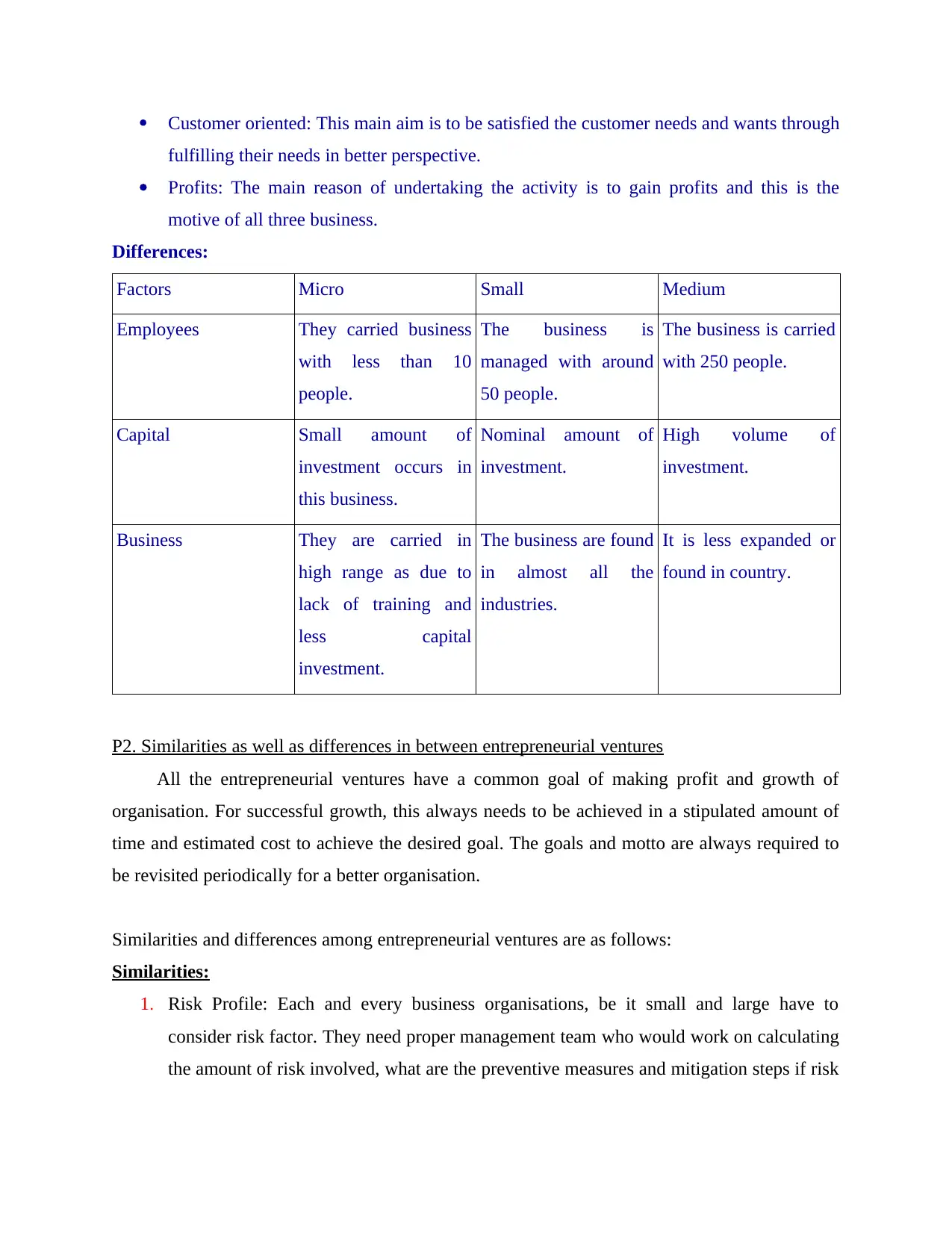
Customer oriented: This main aim is to be satisfied the customer needs and wants through
fulfilling their needs in better perspective.
Profits: The main reason of undertaking the activity is to gain profits and this is the
motive of all three business.
Differences:
Factors Micro Small Medium
Employees They carried business
with less than 10
people.
The business is
managed with around
50 people.
The business is carried
with 250 people.
Capital Small amount of
investment occurs in
this business.
Nominal amount of
investment.
High volume of
investment.
Business They are carried in
high range as due to
lack of training and
less capital
investment.
The business are found
in almost all the
industries.
It is less expanded or
found in country.
P2. Similarities as well as differences in between entrepreneurial ventures
All the entrepreneurial ventures have a common goal of making profit and growth of
organisation. For successful growth, this always needs to be achieved in a stipulated amount of
time and estimated cost to achieve the desired goal. The goals and motto are always required to
be revisited periodically for a better organisation.
Similarities and differences among entrepreneurial ventures are as follows:
Similarities:
1. Risk Profile: Each and every business organisations, be it small and large have to
consider risk factor. They need proper management team who would work on calculating
the amount of risk involved, what are the preventive measures and mitigation steps if risk
fulfilling their needs in better perspective.
Profits: The main reason of undertaking the activity is to gain profits and this is the
motive of all three business.
Differences:
Factors Micro Small Medium
Employees They carried business
with less than 10
people.
The business is
managed with around
50 people.
The business is carried
with 250 people.
Capital Small amount of
investment occurs in
this business.
Nominal amount of
investment.
High volume of
investment.
Business They are carried in
high range as due to
lack of training and
less capital
investment.
The business are found
in almost all the
industries.
It is less expanded or
found in country.
P2. Similarities as well as differences in between entrepreneurial ventures
All the entrepreneurial ventures have a common goal of making profit and growth of
organisation. For successful growth, this always needs to be achieved in a stipulated amount of
time and estimated cost to achieve the desired goal. The goals and motto are always required to
be revisited periodically for a better organisation.
Similarities and differences among entrepreneurial ventures are as follows:
Similarities:
1. Risk Profile: Each and every business organisations, be it small and large have to
consider risk factor. They need proper management team who would work on calculating
the amount of risk involved, what are the preventive measures and mitigation steps if risk
Paraphrase This Document
Need a fresh take? Get an instant paraphrase of this document with our AI Paraphraser
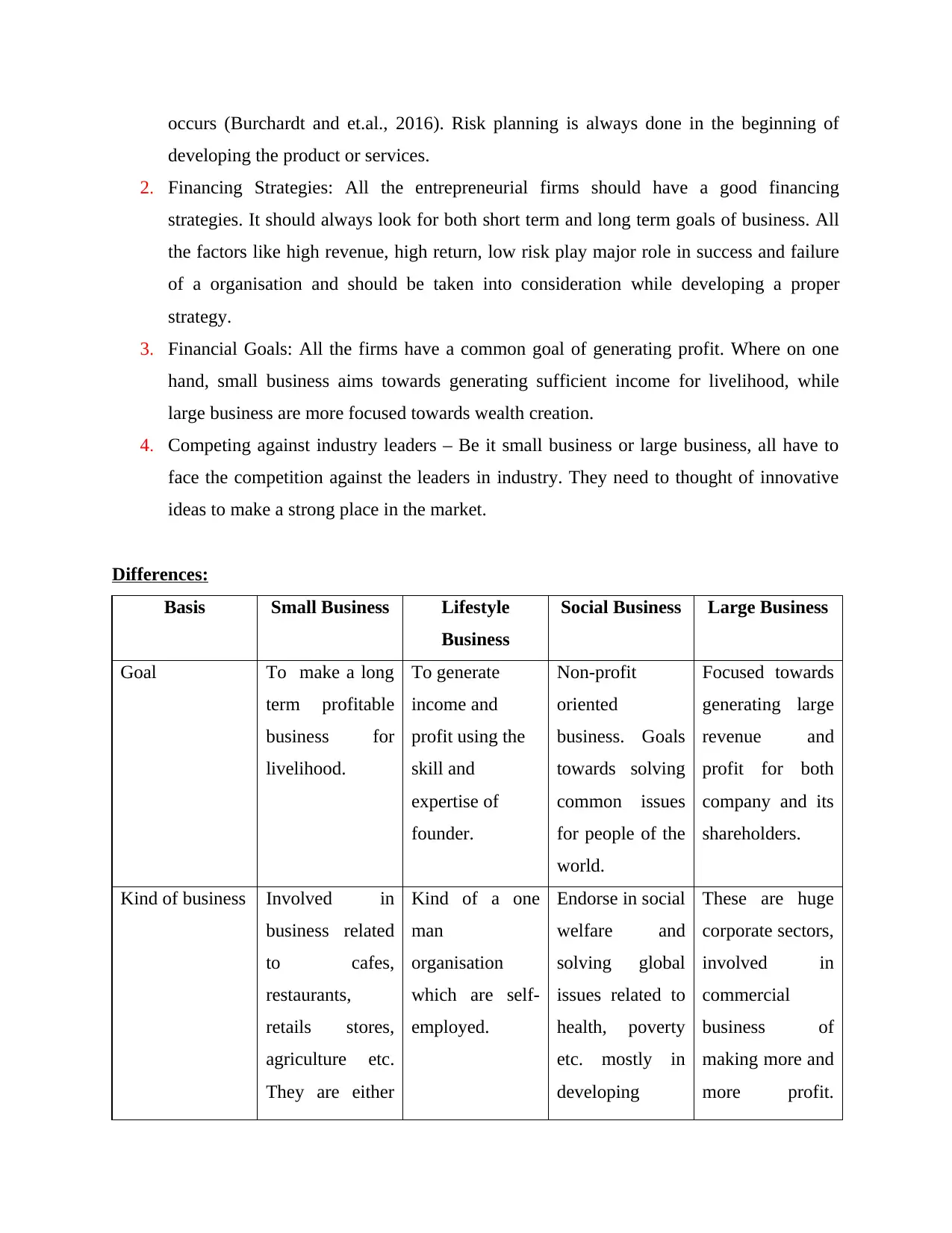
occurs (Burchardt and et.al., 2016). Risk planning is always done in the beginning of
developing the product or services.
2. Financing Strategies: All the entrepreneurial firms should have a good financing
strategies. It should always look for both short term and long term goals of business. All
the factors like high revenue, high return, low risk play major role in success and failure
of a organisation and should be taken into consideration while developing a proper
strategy.
3. Financial Goals: All the firms have a common goal of generating profit. Where on one
hand, small business aims towards generating sufficient income for livelihood, while
large business are more focused towards wealth creation.
4. Competing against industry leaders – Be it small business or large business, all have to
face the competition against the leaders in industry. They need to thought of innovative
ideas to make a strong place in the market.
Differences:
Basis Small Business Lifestyle
Business
Social Business Large Business
Goal To make a long
term profitable
business for
livelihood.
To generate
income and
profit using the
skill and
expertise of
founder.
Non-profit
oriented
business. Goals
towards solving
common issues
for people of the
world.
Focused towards
generating large
revenue and
profit for both
company and its
shareholders.
Kind of business Involved in
business related
to cafes,
restaurants,
retails stores,
agriculture etc.
They are either
Kind of a one
man
organisation
which are self-
employed.
Endorse in social
welfare and
solving global
issues related to
health, poverty
etc. mostly in
developing
These are huge
corporate sectors,
involved in
commercial
business of
making more and
more profit.
developing the product or services.
2. Financing Strategies: All the entrepreneurial firms should have a good financing
strategies. It should always look for both short term and long term goals of business. All
the factors like high revenue, high return, low risk play major role in success and failure
of a organisation and should be taken into consideration while developing a proper
strategy.
3. Financial Goals: All the firms have a common goal of generating profit. Where on one
hand, small business aims towards generating sufficient income for livelihood, while
large business are more focused towards wealth creation.
4. Competing against industry leaders – Be it small business or large business, all have to
face the competition against the leaders in industry. They need to thought of innovative
ideas to make a strong place in the market.
Differences:
Basis Small Business Lifestyle
Business
Social Business Large Business
Goal To make a long
term profitable
business for
livelihood.
To generate
income and
profit using the
skill and
expertise of
founder.
Non-profit
oriented
business. Goals
towards solving
common issues
for people of the
world.
Focused towards
generating large
revenue and
profit for both
company and its
shareholders.
Kind of business Involved in
business related
to cafes,
restaurants,
retails stores,
agriculture etc.
They are either
Kind of a one
man
organisation
which are self-
employed.
Endorse in social
welfare and
solving global
issues related to
health, poverty
etc. mostly in
developing
These are huge
corporate sectors,
involved in
commercial
business of
making more and
more profit.
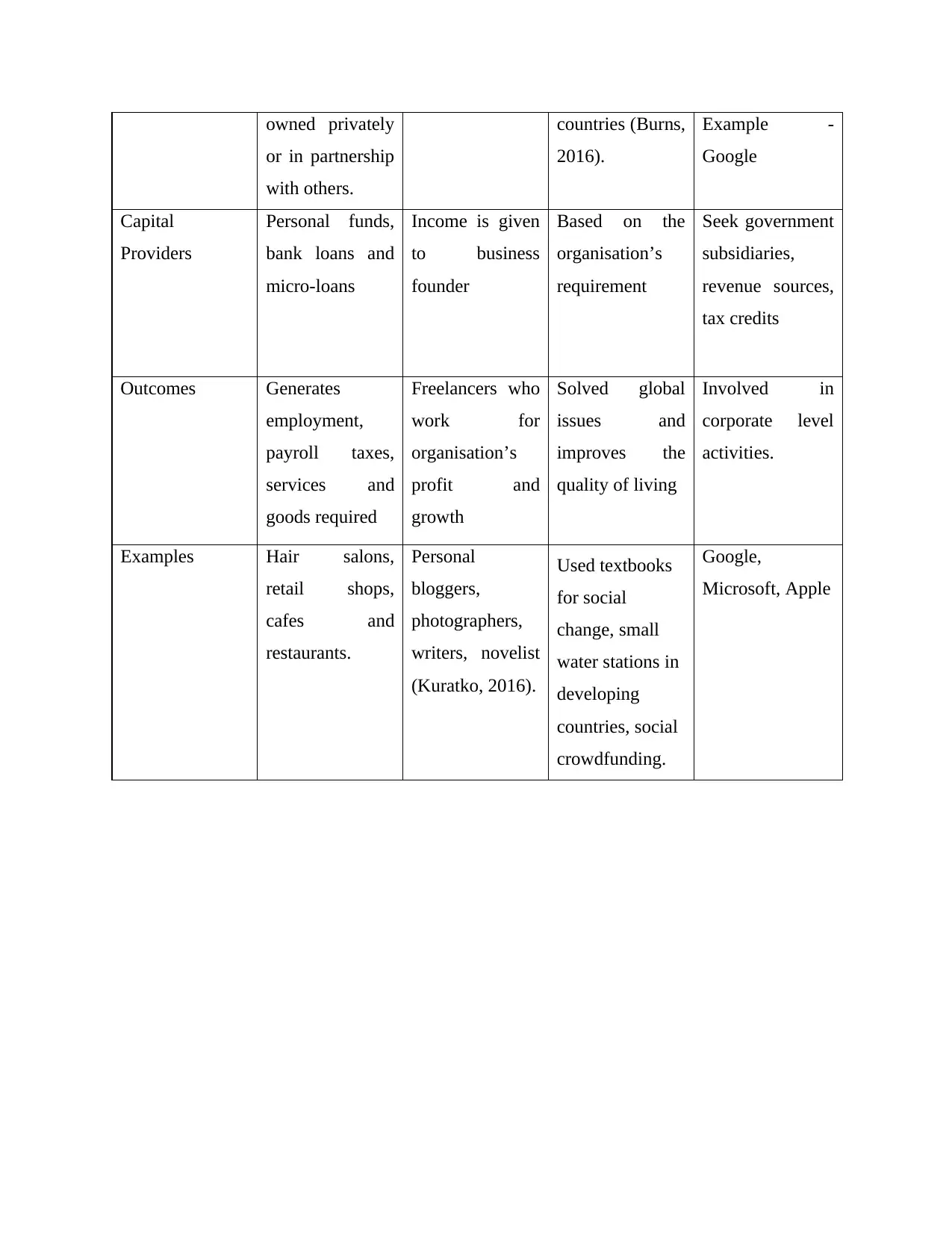
owned privately
or in partnership
with others.
countries (Burns,
2016).
Example -
Google
Capital
Providers
Personal funds,
bank loans and
micro-loans
Income is given
to business
founder
Based on the
organisation’s
requirement
Seek government
subsidiaries,
revenue sources,
tax credits
Outcomes Generates
employment,
payroll taxes,
services and
goods required
Freelancers who
work for
organisation’s
profit and
growth
Solved global
issues and
improves the
quality of living
Involved in
corporate level
activities.
Examples Hair salons,
retail shops,
cafes and
restaurants.
Personal
bloggers,
photographers,
writers, novelist
(Kuratko, 2016).
Used textbooks
for social
change, small
water stations in
developing
countries, social
crowdfunding.
Google,
Microsoft, Apple
or in partnership
with others.
countries (Burns,
2016).
Example -
Capital
Providers
Personal funds,
bank loans and
micro-loans
Income is given
to business
founder
Based on the
organisation’s
requirement
Seek government
subsidiaries,
revenue sources,
tax credits
Outcomes Generates
employment,
payroll taxes,
services and
goods required
Freelancers who
work for
organisation’s
profit and
growth
Solved global
issues and
improves the
quality of living
Involved in
corporate level
activities.
Examples Hair salons,
retail shops,
cafes and
restaurants.
Personal
bloggers,
photographers,
writers, novelist
(Kuratko, 2016).
Used textbooks
for social
change, small
water stations in
developing
countries, social
crowdfunding.
Google,
Microsoft, Apple
⊘ This is a preview!⊘
Do you want full access?
Subscribe today to unlock all pages.

Trusted by 1+ million students worldwide
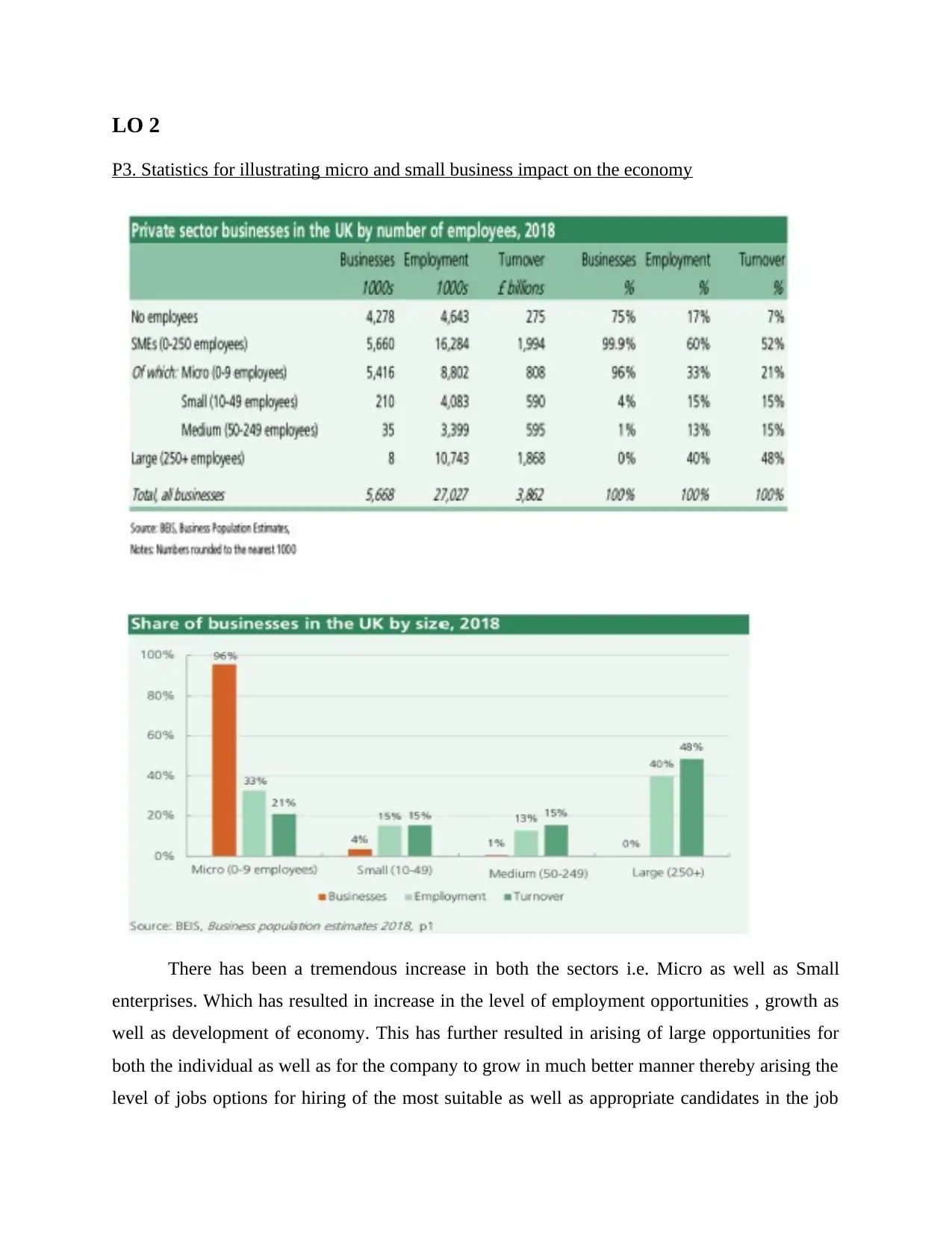
LO 2
P3. Statistics for illustrating micro and small business impact on the economy
There has been a tremendous increase in both the sectors i.e. Micro as well as Small
enterprises. Which has resulted in increase in the level of employment opportunities , growth as
well as development of economy. This has further resulted in arising of large opportunities for
both the individual as well as for the company to grow in much better manner thereby arising the
level of jobs options for hiring of the most suitable as well as appropriate candidates in the job
P3. Statistics for illustrating micro and small business impact on the economy
There has been a tremendous increase in both the sectors i.e. Micro as well as Small
enterprises. Which has resulted in increase in the level of employment opportunities , growth as
well as development of economy. This has further resulted in arising of large opportunities for
both the individual as well as for the company to grow in much better manner thereby arising the
level of jobs options for hiring of the most suitable as well as appropriate candidates in the job
Paraphrase This Document
Need a fresh take? Get an instant paraphrase of this document with our AI Paraphraser
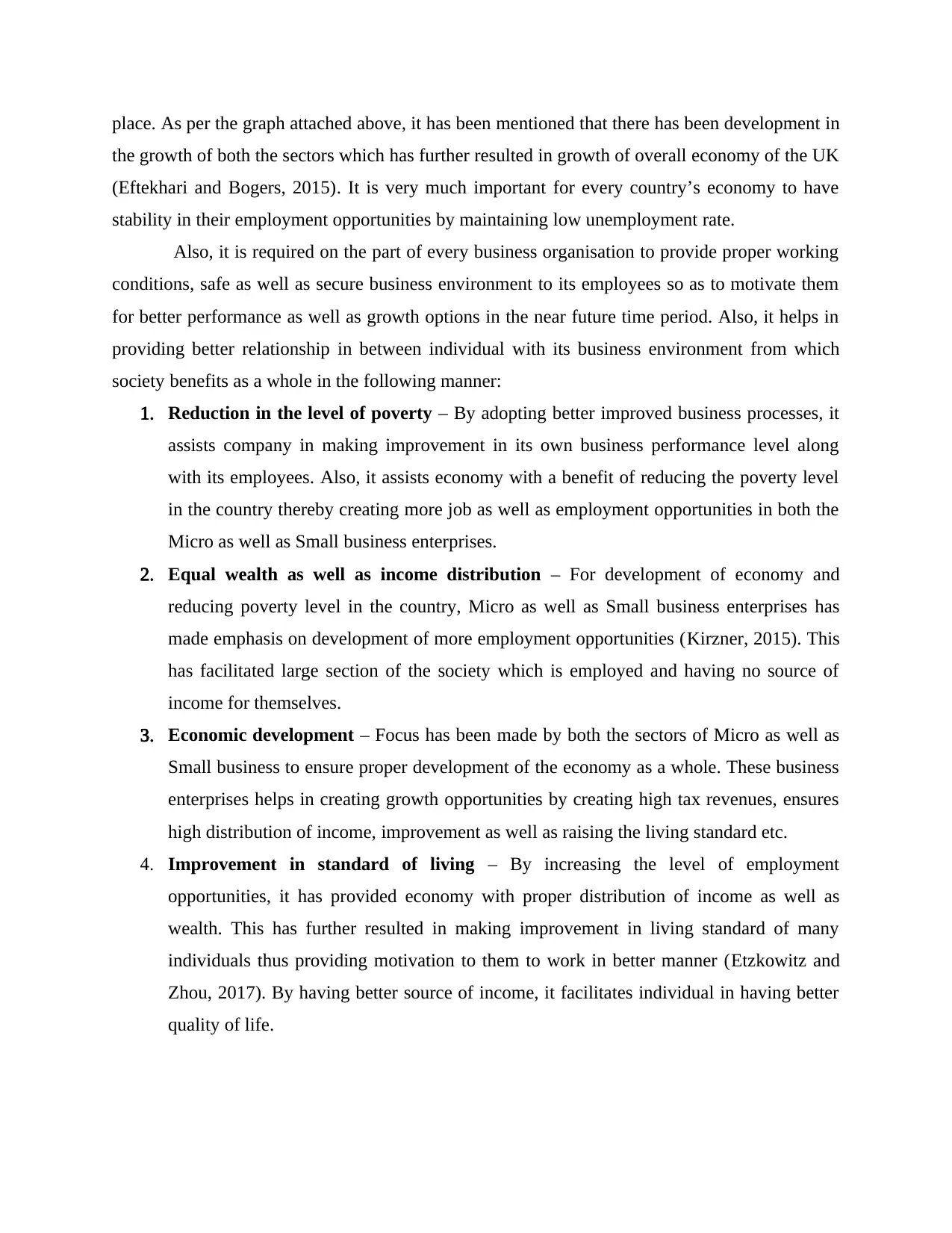
place. As per the graph attached above, it has been mentioned that there has been development in
the growth of both the sectors which has further resulted in growth of overall economy of the UK
(Eftekhari and Bogers, 2015). It is very much important for every country’s economy to have
stability in their employment opportunities by maintaining low unemployment rate.
Also, it is required on the part of every business organisation to provide proper working
conditions, safe as well as secure business environment to its employees so as to motivate them
for better performance as well as growth options in the near future time period. Also, it helps in
providing better relationship in between individual with its business environment from which
society benefits as a whole in the following manner:
1. Reduction in the level of poverty – By adopting better improved business processes, it
assists company in making improvement in its own business performance level along
with its employees. Also, it assists economy with a benefit of reducing the poverty level
in the country thereby creating more job as well as employment opportunities in both the
Micro as well as Small business enterprises.
2. Equal wealth as well as income distribution – For development of economy and
reducing poverty level in the country, Micro as well as Small business enterprises has
made emphasis on development of more employment opportunities (Kirzner, 2015). This
has facilitated large section of the society which is employed and having no source of
income for themselves.
3. Economic development – Focus has been made by both the sectors of Micro as well as
Small business to ensure proper development of the economy as a whole. These business
enterprises helps in creating growth opportunities by creating high tax revenues, ensures
high distribution of income, improvement as well as raising the living standard etc.
4. Improvement in standard of living – By increasing the level of employment
opportunities, it has provided economy with proper distribution of income as well as
wealth. This has further resulted in making improvement in living standard of many
individuals thus providing motivation to them to work in better manner (Etzkowitz and
Zhou, 2017). By having better source of income, it facilitates individual in having better
quality of life.
the growth of both the sectors which has further resulted in growth of overall economy of the UK
(Eftekhari and Bogers, 2015). It is very much important for every country’s economy to have
stability in their employment opportunities by maintaining low unemployment rate.
Also, it is required on the part of every business organisation to provide proper working
conditions, safe as well as secure business environment to its employees so as to motivate them
for better performance as well as growth options in the near future time period. Also, it helps in
providing better relationship in between individual with its business environment from which
society benefits as a whole in the following manner:
1. Reduction in the level of poverty – By adopting better improved business processes, it
assists company in making improvement in its own business performance level along
with its employees. Also, it assists economy with a benefit of reducing the poverty level
in the country thereby creating more job as well as employment opportunities in both the
Micro as well as Small business enterprises.
2. Equal wealth as well as income distribution – For development of economy and
reducing poverty level in the country, Micro as well as Small business enterprises has
made emphasis on development of more employment opportunities (Kirzner, 2015). This
has facilitated large section of the society which is employed and having no source of
income for themselves.
3. Economic development – Focus has been made by both the sectors of Micro as well as
Small business to ensure proper development of the economy as a whole. These business
enterprises helps in creating growth opportunities by creating high tax revenues, ensures
high distribution of income, improvement as well as raising the living standard etc.
4. Improvement in standard of living – By increasing the level of employment
opportunities, it has provided economy with proper distribution of income as well as
wealth. This has further resulted in making improvement in living standard of many
individuals thus providing motivation to them to work in better manner (Etzkowitz and
Zhou, 2017). By having better source of income, it facilitates individual in having better
quality of life.
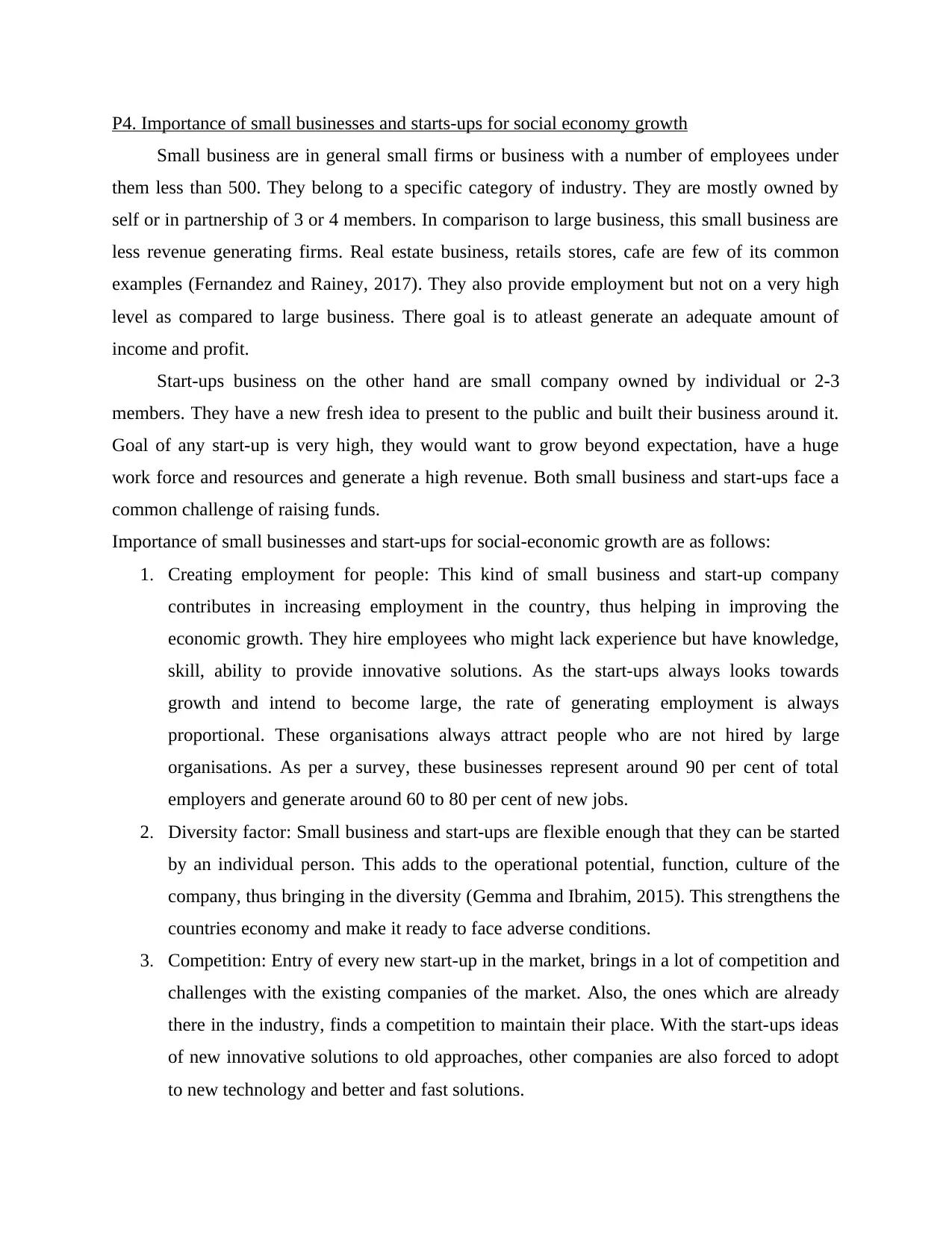
P4. Importance of small businesses and starts-ups for social economy growth
Small business are in general small firms or business with a number of employees under
them less than 500. They belong to a specific category of industry. They are mostly owned by
self or in partnership of 3 or 4 members. In comparison to large business, this small business are
less revenue generating firms. Real estate business, retails stores, cafe are few of its common
examples (Fernandez and Rainey, 2017). They also provide employment but not on a very high
level as compared to large business. There goal is to atleast generate an adequate amount of
income and profit.
Start-ups business on the other hand are small company owned by individual or 2-3
members. They have a new fresh idea to present to the public and built their business around it.
Goal of any start-up is very high, they would want to grow beyond expectation, have a huge
work force and resources and generate a high revenue. Both small business and start-ups face a
common challenge of raising funds.
Importance of small businesses and start-ups for social-economic growth are as follows:
1. Creating employment for people: This kind of small business and start-up company
contributes in increasing employment in the country, thus helping in improving the
economic growth. They hire employees who might lack experience but have knowledge,
skill, ability to provide innovative solutions. As the start-ups always looks towards
growth and intend to become large, the rate of generating employment is always
proportional. These organisations always attract people who are not hired by large
organisations. As per a survey, these businesses represent around 90 per cent of total
employers and generate around 60 to 80 per cent of new jobs.
2. Diversity factor: Small business and start-ups are flexible enough that they can be started
by an individual person. This adds to the operational potential, function, culture of the
company, thus bringing in the diversity (Gemma and Ibrahim, 2015). This strengthens the
countries economy and make it ready to face adverse conditions.
3. Competition: Entry of every new start-up in the market, brings in a lot of competition and
challenges with the existing companies of the market. Also, the ones which are already
there in the industry, finds a competition to maintain their place. With the start-ups ideas
of new innovative solutions to old approaches, other companies are also forced to adopt
to new technology and better and fast solutions.
Small business are in general small firms or business with a number of employees under
them less than 500. They belong to a specific category of industry. They are mostly owned by
self or in partnership of 3 or 4 members. In comparison to large business, this small business are
less revenue generating firms. Real estate business, retails stores, cafe are few of its common
examples (Fernandez and Rainey, 2017). They also provide employment but not on a very high
level as compared to large business. There goal is to atleast generate an adequate amount of
income and profit.
Start-ups business on the other hand are small company owned by individual or 2-3
members. They have a new fresh idea to present to the public and built their business around it.
Goal of any start-up is very high, they would want to grow beyond expectation, have a huge
work force and resources and generate a high revenue. Both small business and start-ups face a
common challenge of raising funds.
Importance of small businesses and start-ups for social-economic growth are as follows:
1. Creating employment for people: This kind of small business and start-up company
contributes in increasing employment in the country, thus helping in improving the
economic growth. They hire employees who might lack experience but have knowledge,
skill, ability to provide innovative solutions. As the start-ups always looks towards
growth and intend to become large, the rate of generating employment is always
proportional. These organisations always attract people who are not hired by large
organisations. As per a survey, these businesses represent around 90 per cent of total
employers and generate around 60 to 80 per cent of new jobs.
2. Diversity factor: Small business and start-ups are flexible enough that they can be started
by an individual person. This adds to the operational potential, function, culture of the
company, thus bringing in the diversity (Gemma and Ibrahim, 2015). This strengthens the
countries economy and make it ready to face adverse conditions.
3. Competition: Entry of every new start-up in the market, brings in a lot of competition and
challenges with the existing companies of the market. Also, the ones which are already
there in the industry, finds a competition to maintain their place. With the start-ups ideas
of new innovative solutions to old approaches, other companies are also forced to adopt
to new technology and better and fast solutions.
⊘ This is a preview!⊘
Do you want full access?
Subscribe today to unlock all pages.

Trusted by 1+ million students worldwide
1 out of 20
Related Documents
Your All-in-One AI-Powered Toolkit for Academic Success.
+13062052269
info@desklib.com
Available 24*7 on WhatsApp / Email
![[object Object]](/_next/static/media/star-bottom.7253800d.svg)
Unlock your academic potential
Copyright © 2020–2025 A2Z Services. All Rights Reserved. Developed and managed by ZUCOL.




